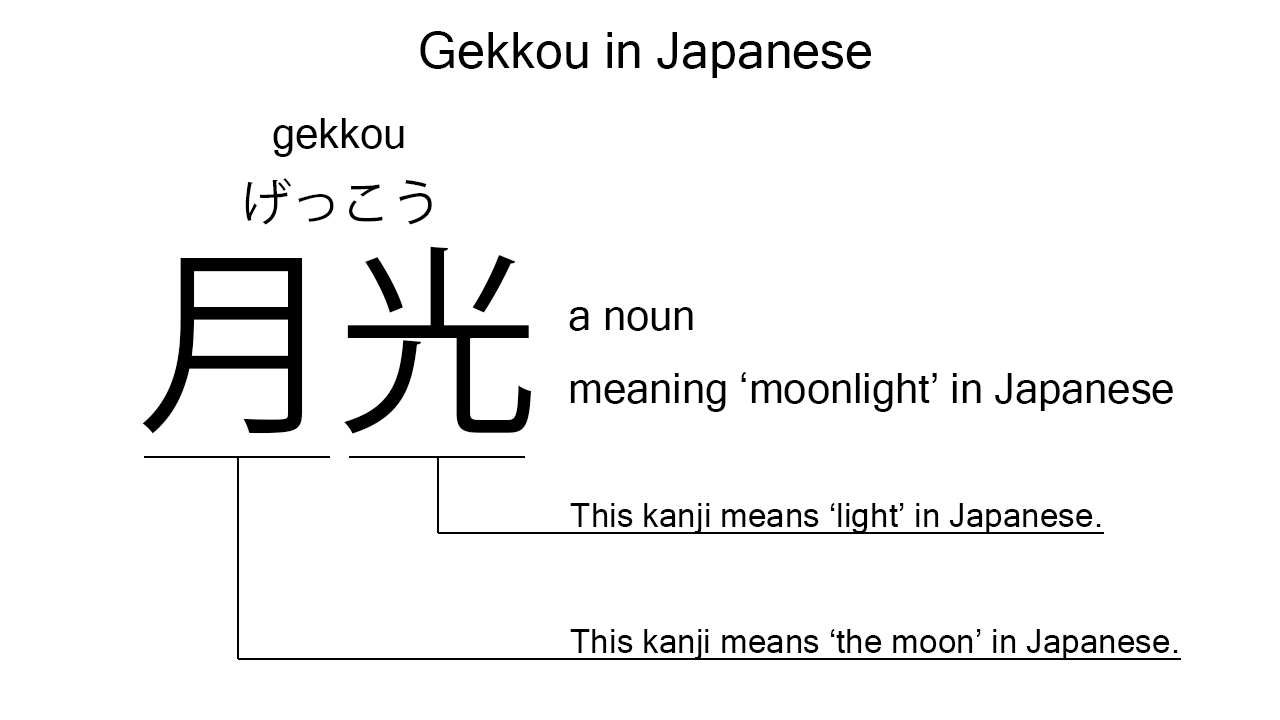What does “gekkou” mean in Japanese?
Native speakers use gekkou to mean ‘moonlight’ in Japanese. Perhaps, some Japanese learners know this word as it is sometimes used in Japanese movies, songs, novels, manga, anime, and the like. In this blog post, however, I’m explaining this word in detail based on its kanji expression. And also, I’m explaining how to use it through example sentences. My explanations would help Japanese learners understand gekkou more clearly. Then, let’s get started!
Contents
Definition and meaning of “gekkou”
Let me start with the definition and meaning of gekkou.
- gekkou – 月光 (げっこう) : a noun meaning ‘moonlight’ in Japanese.
The definition and meaning are simple and clear. To understand this noun more clearly, however, let me explain its kanji characters in detail, one by one.
Japanese kanji for ‘moonlight’
The Japanese kanji expression for ‘moonlight’ consists of the following two kanji characters:
- 月 : a kanji character used to mean ‘the moon’ in Japanese.
- 光 : a kanji character used to mean ‘light’ in Japanese.
From these two kanji characters, we can understand that gekkou literally means ‘moonlight’ in Japanese. This literal interpretation is completely in line with the actual meaning.

When we meet new kanji expressions, we should check their kanji characters in detail to understand their meanings clearly and deeply. In many cases, kanji characters tell us a lot about the meanings of the expressions they form. Actually, here, we could get the better understanding of gekkou through the detailed kanji check above.
So far, I’ve explained the definition and meaning of gekkou together with its kanji characters. Then, let me explain how to use it through the example sentences below.
How to say “moonlight” in Japanese
kon’ya wa gekkou ga totemo utsukushii – 今夜は月光がとても美しい (こんやはげっこうがとてもうつくしい)
The moonlight is very beautiful tonight.
Below are the new words used in the example sentence.
- kon’ya – 今夜 (こんや) : a noun meaning ‘tonight’ in Japanese.
- wa – は : a binding particle working as a case marker or topic marker. In the example, this works as a topic marker after kon’ya to put a focus on it.
- ga – が : a case particle used to make the subject word or the object word in a sentence. In the example, this is used after gekkou to make the subject in the sentence.
- totemo – とても : an adverb of degree meaning ‘very’, ‘much’, ‘so’, or such in Japanese. In the example, this works in front of utsukushii to emphasize its meaning.
- utsukushii – 美しい (うつくしい) : an i-adjective meaning ‘beautiful’ in Japanese.
This is a typical usage of gekkou. In this example, it works together with the case particle, ga, to become the subject in the sentence. When we want to mean ‘moonlight’ in Japanese, this noun is always a very good option.
Another example of “gekkou”
watashi tachi wa gekkou no shita wo arui ta – 私達は月光の下を歩いた (わたしたちはげっこうのしたをあるいた)
We walked in the moonlight.
Below are the new words used in the example sentence.
- watashi – 私 (わたし) : a pronoun meaning ‘I’ in Japanese.
- tachi – 達 (たち) : a suffix used after a noun or pronoun to make its plural form. In the example, this is used after watashi to make its plural form, watashi tachi, which means ‘we’ in Japanese. Learn more about Japanese plural.
- no – の : a case particle used to join two nouns. Normally, the first one can work as a modifier to describe the second. In the example, this is used to join gekkou and shita. The formed phrase literally means ‘the underneath of the moonlight’ in Japanese. It has been translated as just ‘in the moonlight,’ though.
- shita – 下 (した) : a noun meaning ‘underneath’ in Japanese.
- wo – を : a case particle used to make the object word in a sentence. In the example, this is used after gekkou no shita to make the object in the sentence.
- arui – 歩い (あるい) : one conjugation of the verb, aruku, which means ‘to walk’ in Japanese. In the example, it has been conjugated for the better connection with its following word.
- ta – た : an auxiliary verb used after a verb, adjective, or auxiliary verb to make its past tense form. In the example, this is used after arui to make its past tense form, arui ta.
This is another example of gekkou. In this example, it works together with no shita to mean ‘in the moonlight’ in Japanese.
Summary
In this blog post, I’ve explained the definition and meaning of gekkou in detail based on its kanji expression. And also, I’ve explained how to use it through the example sentences. Let me summarize them as follows.
- gekkou – 月光 (げっこう) : a noun meaning ‘moonlight’ in Japanese. These two kanji characters literally mean ‘moonlight’ in Japanese. This literal interpretation is completely in line with the actual meaning.
Hope my explanations are understandable and helpful for Japanese learners.
Leave a Reply